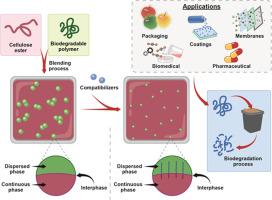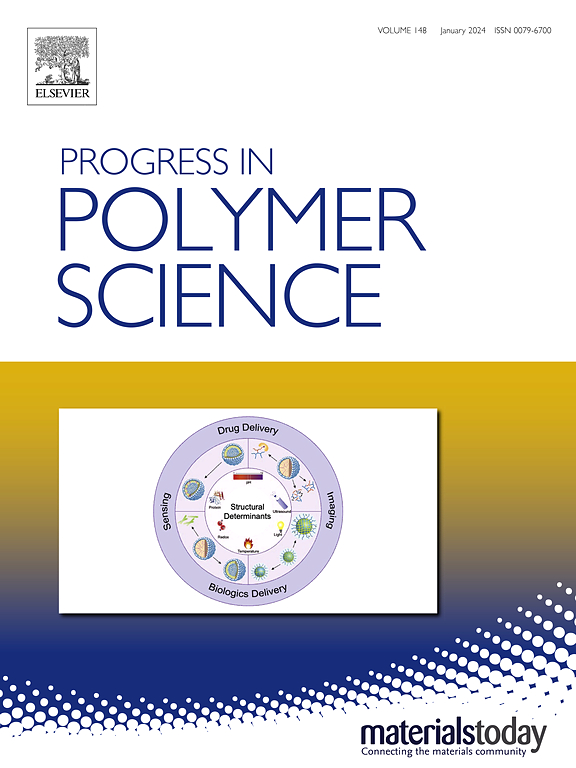可生物降解纤维素酯共混物:研究、增容、可生物降解行为和应用。回顾
IF 26.1
1区 化学
Q1 POLYMER SCIENCE
引用次数: 0
摘要
不断增长的塑料生产、人口和消费正在加剧环境污染和浪费。如果不改变,到2050年,120亿吨塑料垃圾将填满垃圾填埋场或自然环境。从化石燃料时代走向可持续发展,需要使用排放最少或净零碳排放的先进可再生材料。纤维素是自然界中发现的最丰富的生物聚合物,是设计功能材料的重要基础。本文综述了纤维素酯化制备特定有机纤维素酯(CEs)、加入改性剂提高加工性能以及与生物聚合物共混作为获得具有更高性能和成本的材料的有力方法等方面的研究空白。为了充分挖掘这种方法的潜力,有必要进一步研究这些材料的混相性、结构和性能之间的相关性。ce与其他生物聚合物的混相可以变化,部分或完全混相归因于聚合物的化学性质,亲疏水性和疏水性。这种变化是研究当前兼容策略的一个关键原因。本文旨在研究生物可降解聚合物与CE共混物增容策略的进展,以及未改性和改性共混物的生物降解行为和应用。本文章由计算机程序翻译,如有差异,请以英文原文为准。


Biodegradable cellulose ester blends: Studies, compatibilization, biodegradable behavior, and applications. A review
Growing plastic production, population, and consumption are driving increased environmental pollution and waste. Without change, 12 billion metric tons of plastic waste could fill landfills or natural environments by 2050. Moving beyond the fossil fuel era towards sustainability demands using advanced renewable materials that emit minimal, or net-zero carbon emissions. Cellulose, the most abundant biopolymer found in nature, is a compelling foundation for designing functional materials. This review paper fills the void regarding the esterification of cellulose to obtain specific organic cellulose esters (CEs), its modification by incorporating agents for improved processability, and blending with biopolymers as a powerful method for obtaining materials with enhanced property-to-cost performance. Further investigation is necessary to delve into the correlations among miscibility, structure, and properties of these materials to fully exploit the potential of this approach. The miscibility of CEs with other biopolymers can vary, with partial or complete miscibility attributed to the chemical nature of polymers, hydrophilic and hydrophobic properties. This variation is a key reason for studying current compatibilization strategies. This article aims to examine the advancements in strategies for compatibilizing CE blends with biodegradable polymers, along with exploring the biodegradation behavior and applications of both unmodified and modified blends.
求助全文
通过发布文献求助,成功后即可免费获取论文全文。
去求助
来源期刊

Progress in Polymer Science
化学-高分子科学
CiteScore
48.70
自引率
1.10%
发文量
54
审稿时长
38 days
期刊介绍:
Progress in Polymer Science is a journal that publishes state-of-the-art overview articles in the field of polymer science and engineering. These articles are written by internationally recognized authorities in the discipline, making it a valuable resource for staying up-to-date with the latest developments in this rapidly growing field.
The journal serves as a link between original articles, innovations published in patents, and the most current knowledge of technology. It covers a wide range of topics within the traditional fields of polymer science, including chemistry, physics, and engineering involving polymers. Additionally, it explores interdisciplinary developing fields such as functional and specialty polymers, biomaterials, polymers in drug delivery, polymers in electronic applications, composites, conducting polymers, liquid crystalline materials, and the interphases between polymers and ceramics. The journal also highlights new fabrication techniques that are making significant contributions to the field.
The subject areas covered by Progress in Polymer Science include biomaterials, materials chemistry, organic chemistry, polymers and plastics, surfaces, coatings and films, and nanotechnology. The journal is indexed and abstracted in various databases, including Materials Science Citation Index, Chemical Abstracts, Engineering Index, Current Contents, FIZ Karlsruhe, Scopus, and INSPEC.
 求助内容:
求助内容: 应助结果提醒方式:
应助结果提醒方式:


